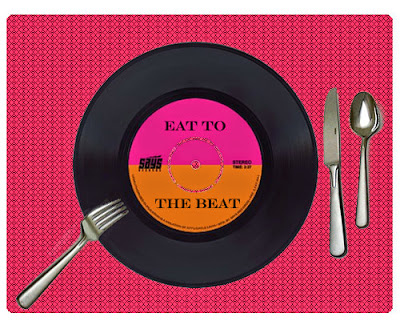It’s said that the color red is supposed to stimulate the
appetite. Bright dining room lights (vs.
dim) are supposed to make you eat faster.
Textures and appearance are critical to your eating mood, especially if
you’ve ever eaten sushi. Restaurants pay
thousands of dollars installing sound-dampening panels to ensure when they
fill, it doesn’t sound like The Super Bowl.
But, what about the effect of music on your eating habits?
The speed of music played during a meal directly affects the
pace of eating, and thus the rate or ease of digestion. Studies have shown a mild increase in the
rate at which people eat when there is spirited music versus gentle
classical. And louder, more aggressive
music works the opposite way, reducing the number of bites and leaving the
eater with an irritated, uneasy feeling.
This trade secret has long been in the quiver for many unscrupulous, if
savvy, restaurateurs looking to turn tables in a pinch. And, if you’re the last table of the night
and suddenly notice the music shut off, that’s your cue to hit the road, Jack.
There are obvious arguments for music in restaurants, most
of them common sense. Music provides an
ambient noise that makes people feel more relaxed to talk among dinner guests
without being self-conscious of others listening in. Also, music is a useful fog for that
sensitive discussion between acquaintances, attorneys or would-be cheaters. Music in a major key is more melodic to the
ear and relaxing than minor, or dissonant tones; for example, Jack Johnson good,
The Cure, bad. In a public dining room,
melodic rhymes relieve diner tension; Bustah Rhymes, causes it. This same aural psychology is applied in
casinos. A cacophony of slot machine clatter
would drive anyone mad after 10 minutes, but in a harmonic loop of arpeggios, the
bings and bongs of winning machines become hypnotic.
Music is personal and subjective. Whether you’re preparing a meal or eating
one, we play what makes us feel good. It
motivates! Home cooks and line cooks
rarely share the same playlists, of this you can be sure, but both hook in and
stir it up to their own personal soundtrack.
A little bossa nova, Coltrane or café accordion can relax the soul when
putting together a leisurely Sunday supper for the family. Alternately, a gritty grill cook breathes a
little easier when the occasional f-bomb or axe solo grinds out of the Ipod
dock. Music is also a cheap and
accessible pressure valve.
Not every professional kitchen, however, condones
music. Even in my own first kitchen, I
wanted complete focus. As much of an
audiophile as I considered myself, I wasn’t willing to let details slide if
someone was off in a Pink Floyd fantasy.
But, one afternoon while prepping for a party, I was alone and threw on
some Rolling Stones to get me over the hump.
When the cooks arrived, they smiled, put on aprons and quietly went to
work. I’m pretty sure the food was some
of the best we put out. From that moment
on, I’ve always shared the stereo with my cooks.
Here is an example where music may have actually helped
improve the quality of food of an establishment. One of the hottest and most revered
restaurants in the world is Eleven Madison Park in New York City . In 2006, when a critic reviewed the
restaurant, though her comments were favorable, she lamented that the kitchen
could use “a bit more Miles Davis”. Without
fully understanding what she meant, the line resonated with the chef and
manager. So, Swiss-born chef Daniel Humm
read as many articles as he could find about Miles, and came up with a list of
the words most commonly used to describe him. The list included: cool, collaborative, fresh,
vibrant, endless reinvention and spontaneous, to name a few. Today, the sounds of his quartet and quintet
can be heard piped into the kitchen as well as the dining room. And, a reverent black and white framed photo
of the trumpet master hangs in the Spartan kitchen. Last month Humm was named Best Chef in the US by
the James Beard Foundation, and Eleven Madison Park among the top 10 restaurants
in the world, with three Michelin Stars and four from the New York Times. Cool,
indeed.
Music can affect mood, even if you’re not aware of it. When the Shoprite at the waterfront opened a
few years back, I queued up like everyone else to see what modern marvels
awaited the culinary curious. Much to my
surprise, I first noticed not the shiny floors and pyramids of produce, but the
music that was playing. There was a
smart playlist piped in of 80s tunes from slightly off the beaten path. It added an unconscious spring to my step and
made me take note of the age of other shoppers, mostly under 40, also tapping
their toes. Grocery shopping cool?
It could happen. But, I get
it. We all have to shop, so any little
nugget of newness can be a tipping point for customers looking to break up the
monotony. “When I met you in the res-tau-rant.
You could tell I was no debutante!”
Originally published in Out & About Magazine June 2012




